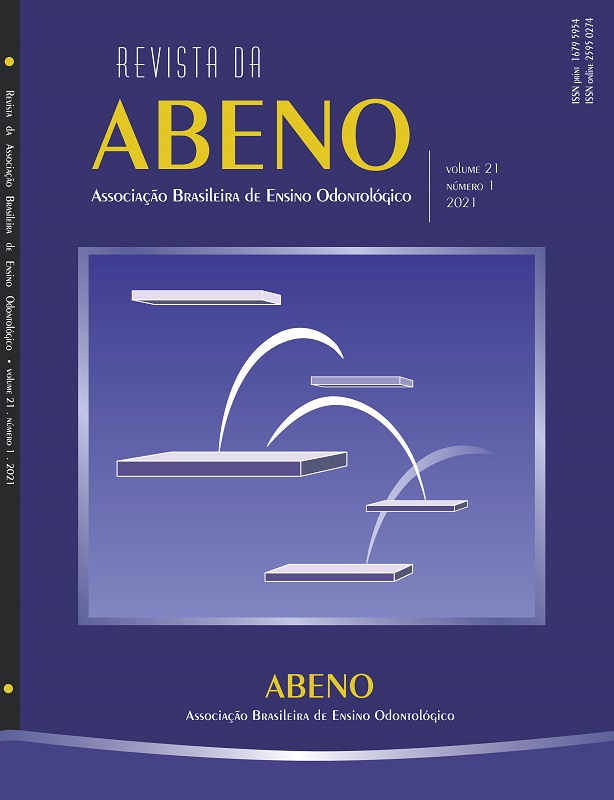Uso da aprendizagem colaborativa como ferramenta para avaliar anomalias craniofaciais sindrômicas
DOI:
https://doi.org/10.30979/revabeno.v21i1.1544Palavras-chave:
Fissura Palatina, Educação em odontologia, Práticas interdisciplinares.Resumo
Almost 30% of oral clefts are associated with other structural abnormalities. However, little is known on orofacial characteristics associated with these cases since they are not systematically reported. To close this gap, we developed a collaborative learning approach supported by an interprofessional team aiming to carefully describe oral findings and impact the training of future professionals that hopefully will incorporate these descriptions on their clinical practice. The methodological proposal consisted of small group sessions focusing on a particular syndrome or group of syndromes followed by the examination of patients with those conditions. Twenty cases were examined and studied over the course of one semester and a set of conditions to be identified in the orofacial region was defined. Here, we present a guideline that we suggest that dentists and dental institutions use. We also present the advantages of using collaborative learning as a tool in the training of the clinician.
Downloads
Referências
(1) McHugh M, Van Dyke KJ, Howell E, Adams F, Moss D, Yonek J. Changes in Patient Flow Among Five Hospitals Participating in a Learning Collaborative. J Healthc Qual. 2013; 35 (1): 21-9.
(2) Bines JE, Jamieson P. Designing new collaborative learning spaces in clinical environments: experiences from a children’s hospital in Australia. J Interprof Care. 2013; 27 (Sup2): 63-8.
(3) Corbella X, Barreto V, Bassetti S, Bivol M, Castellino P, Kruijf EJ et al. Hospital ambulatory medicine: A leading strategy for Internal Medicine in Europe. Eur J Intern Med. 2018; 54, 17–20.
(4) Auerbach AD, Patel MS, Metlay JP, Schnipper JL , Williams MV, Robinson EJ et al. The Hospital Medicine Reengineering Network (HOMERuN). Acad Med. 2014; 9 (3): 415-20.
(5) Lippe M, Linton B, Jones B. Utilizing a collaborative learning activity to sensitize interprofessional students to palliative care scopes of practice with adolescent and young adults. J Interprof Care. 2019; 33 (2): 267-9.
(6) Lqbal M, Velan GM, O’Sullivan AJ, Balasooriya C. The collaborative learning development exercise (CLeD-EX): an educational instrument to promote key collaborative learning behaviours in medical students. BMC Med Educ. 2020; 20 (1): 1-11.
(7) Rowan M, Catherine F, Paul S, Sathyamoorthy G, Barlow J, Pomeroy L. Professionals learning together with patients: Anexploratory study of a collaborative learning Fellowship programme for healthcare improvement. J Interprof Care. 2018; 32 (3): 257-65.
(8) Zhang J, Cui Q. Collaborative Learning in Higher Nursing Education: A Systematic Review. J Prof Nurs. 2018; 34 (5): 378-88.
(9) Vieira AR. Genetic and environmental factors in human cleft lip and palate. Front Oral Biol. 2012; 16:19-31.
(10) Koruyucu M, Kasimoğlu Y, Seymen F, Bayram M, Patir A, Ergöz N et al, Rethinking isolated cleft lip and palate as a syndrome. Oral Surg Oral Med Oral Pathol Oral Radiol. 2018;125 (4): 307-12.
(11) Kantaputra PN, Sumitsawan Y, Schutte BC, Tochareontanaphol BC. Van der Woude syndrome with sensorineural hearing loss, large craniofacial sinuses, dental pulp stones, and minor limb anomalies: Report of a four‐generation Thai family. Am J Med Genet. 2002; 108 (4): 275-80.
(12) Zucchero TM, Cooper ME, Maher BS, Daack-Hirsch S, Nepomuceno B, Ribeiro L et al. Interferon regulatory factor 6 (IRF6) gene variants and the risk of isolated cleft lip or palate. New Engl J Med. 2004; 351 (8): 769-80.
(13) Vieira AR, Modesto A, Meira R, Barbosa ARS, Lidral AC, Murray JC. Interferon regulatory factor 6 (IRF6) and fibroblast growth factor receptor 1 (FGFR1) contribute to human tooth agenesis. Am J Med Genet A. 2007; 143 (6): 538-45.
(14) Biggs J, Tang C. Teaching for quality learning at university. 3ª ed. England: Open University Press. 2007.
(15) DePaola D. The evolution of dental education, 1936-2011, and the Role of the Journal of Dental Education. J Dent Educ. 2012; 76 (1):14-27.
(16) Wang Z, Feng F, Gao S, Yang J. A Systematic Meta-Analysis of the Effect of Interprofessional Education on Health Professions Students’ Attitudes. J Dent Educ. 2019; 83 (12): 1361-9.
(17) Chism, NVN. A tale of two classrooms. New Directions for Teaching and Learning. 2002; (92): 5–12.
(18) Assael L. Current Status of Postdoctoral and Graduate Programs in Dentistry. J Dent Educ. 2017; 81 (8): eS41-eS9.
(19) Coleman AJ, Finn GM, Nattress BR. Interprofessional education in dentistry.
Br Dent J. 2018; 225: 257-62.
Downloads
Publicado
Como Citar
Edição
Seção
Licença
Copyright (c) 2021 Revista da ABENO

Este trabalho está licenciado sob uma licença Creative Commons Attribution-NonCommercial 4.0 International License.
Autores que publicam nesta revista concordam com os seguintes termos:
a) Autores mantém os direitos autorais e concedem à revista o direito de primeira publicação, com o trabalho simultaneamente licenciado sob a Licença Creative Commons Attribution que permite o compartilhamento do trabalho com reconhecimento da autoria e publicação inicial nesta revista.
b) Autores têm autorização para assumir contratos adicionais separadamente, para distribuição não-exclusiva da versão do trabalho publicada nesta revista (ex.: publicar em repositório institucional ou como capítulo de livro), com reconhecimento de autoria e publicação inicial nesta revista.
c) Autores têm permissão e são estimulados a publicar e distribuir seu trabalho online (ex.: em repositórios institucionais ou na sua página pessoal) a qualquer ponto antes ou durante o processo editorial, já que isso pode gerar alterações produtivas, bem como aumentar o impacto e a citação do trabalho publicado (Veja O Efeito do Acesso Livre).






